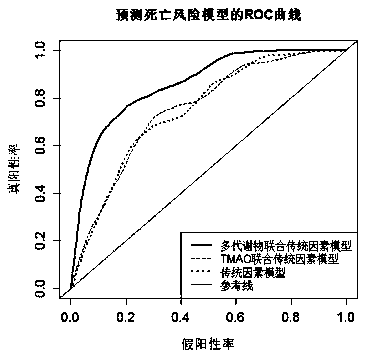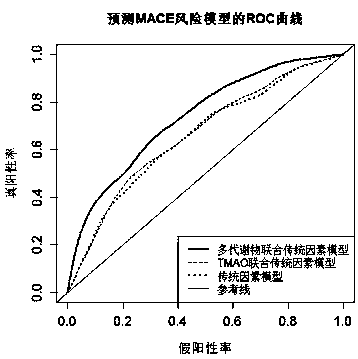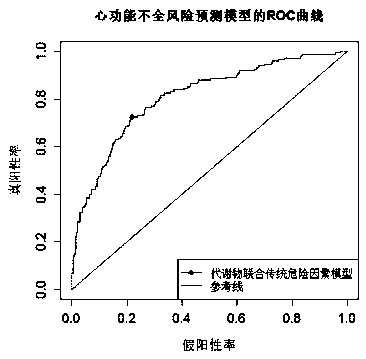Composition of marker for predicting prognosis of coronary heart disease and kit thereof
A technology of metabolites and coronary heart disease, applied in the field of coronary heart disease detection, can solve the problems of limited prediction efficiency and achieve the effect of improving prognosis and reducing mortality
- Summary
- Abstract
- Description
- Claims
- Application Information
AI Technical Summary
Problems solved by technology
Method used
Image
Examples
Embodiment 1
[0075] Example 1 Combination analysis of metabolic markers for risk of death
[0076] 1. Experimental operation
[0077] 1. Case source
[0078] This study recruited 1040 patients with coronary heart disease, and all the selected patients signed the informed consent. All patients were sequentially enrolled between January 2010 and December 2013 according to the same inclusion and exclusion criteria. The average age of the research subjects was 63.03±10.04 years old, the average BMI was 24.28±4.79kg / m2, and about 80% were male. The clinical data of the patients included demographic data, past medical history, laboratory tests and past medication history. During the 5-year follow-up, there were 63 deaths and 183 MACEs among 1040 CHD patients.
[0079] The time of blood collection was in the morning on an empty stomach.
[0080] Follow-up information was collected on the basis of inpatient and hospital outpatient visits, and telephone follow-up of all enrolled patients or th...
Embodiment 2
[0108] Metabolic Marker Combination Analysis of Example 2 MACE Analysis
[0109] 1. Experimental operation
[0110] To identify combinations of metabolic markers associated with MACE risk, COX regression was used to analyze the association of metabolites with MACE risk. Concrete operation is with embodiment 1.
[0111] 2. Experimental results
[0112] After adjusting for potential confounding factors including age, gender, BMI, SYNTAX score, complications, liver and kidney function, and drug treatment, multivariate COX regression analysis showed that 20 metabolites were still associated with the risk of MACE (P <0.05, Table 3), including lyso-lecithin 20:2 (LysoPC 20:2), lyso-lecithin 20:2 (2n isomer) (LysoPC 20:2 (2n isomer)), 5-methyl Uridine (5-Methyluridine), 4-Acetamidobutyric acid (4-Acetamidobutyric acid), L-Kynurenine (L-Kynurenine), LysoPC 20:1 (LysoPC 20:1), D-Sorbitol (D-Sorbitol), Dulcitol, LysoPC 20:0 (LysoPC 20:0), LysoPC 20:1 (2n isomer) (LysoPC 20:1 (2n iso...
Embodiment 3
[0116] Example 3 Combination analysis of metabolic markers for cardiac insufficiency (LVEF<50%)
[0117] 1. Experimental operation
[0118] In order to identify plasma metabolites associated with cardiac insufficiency, Logistic regression was used to analyze the correlation of plasma metabolites with cardiac insufficiency (LVEF<50%). According to the value of LVEF, 833 patients with LVEF data were divided into two groups, 152 cases with LVEF<50% (cases), and 681 cases with LVEF≥50% (control).
[0119] Concrete steps are as embodiment 1.
[0120] 2. Experimental results
[0121] After adjusting for several potential confounding factors including demographics, clinical measures, prevalent comorbidities, and concomitant medications, multivariate Logistic regression analysis showed that 32 metabolites were statistically associated with LVEF Significance (P<0.05, Table 5), including dimethylguanosine (2-(dimethylamino)guanosine), creatine (Creatine), N6-acetyl-L-lysine (N6-Acety...
PUM
 Login to View More
Login to View More Abstract
Description
Claims
Application Information
 Login to View More
Login to View More - R&D
- Intellectual Property
- Life Sciences
- Materials
- Tech Scout
- Unparalleled Data Quality
- Higher Quality Content
- 60% Fewer Hallucinations
Browse by: Latest US Patents, China's latest patents, Technical Efficacy Thesaurus, Application Domain, Technology Topic, Popular Technical Reports.
© 2025 PatSnap. All rights reserved.Legal|Privacy policy|Modern Slavery Act Transparency Statement|Sitemap|About US| Contact US: help@patsnap.com



